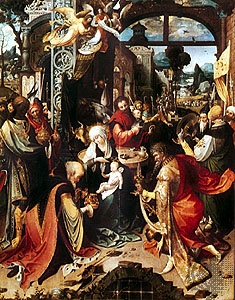Magi
biblical figures
singular Magus, also called Wise Men
 in Christian tradition, the noble pilgrims “from the East” who followed a miraculous guiding star to Bethlehem, where they paid homage to the infant Jesus as king of the Jews (Matthew 2:1–12). Christian theological tradition has always stressed that Gentiles as well as Jews came to worship Jesus—an event celebrated in the Eastern church at Christmas and in the West at Epiphany (January 6). Eastern tradition sets the number of Magi at 12, but Western tradition sets their number at 3, probably based on the three gifts of “gold and frankincense and myrrh” (Matthew 2:11) presented to the infant.
in Christian tradition, the noble pilgrims “from the East” who followed a miraculous guiding star to Bethlehem, where they paid homage to the infant Jesus as king of the Jews (Matthew 2:1–12). Christian theological tradition has always stressed that Gentiles as well as Jews came to worship Jesus—an event celebrated in the Eastern church at Christmas and in the West at Epiphany (January 6). Eastern tradition sets the number of Magi at 12, but Western tradition sets their number at 3, probably based on the three gifts of “gold and frankincense and myrrh” (Matthew 2:11) presented to the infant. The Gospel of Matthew (Matthew, Gospel According to) relates how at Jerusalem they attracted the interest of King Herod I of Judaea by announcing Jesus' birth: “Where is he who has been born king of the Jews? For we have seen his star (Bethlehem, Star of) in the East, and have come to worship him” (Matthew 2:2). Herod extracted from them the place of Jesus' birth, requesting that they disclose the exact spot upon their return. They continued on to Bethlehem, where they worshiped Jesus and offered him gifts. Warned in a dream not to return to Herod, “they departed to their own country by another way” (Matthew 2:12).
The Gospel of Matthew (Matthew, Gospel According to) relates how at Jerusalem they attracted the interest of King Herod I of Judaea by announcing Jesus' birth: “Where is he who has been born king of the Jews? For we have seen his star (Bethlehem, Star of) in the East, and have come to worship him” (Matthew 2:2). Herod extracted from them the place of Jesus' birth, requesting that they disclose the exact spot upon their return. They continued on to Bethlehem, where they worshiped Jesus and offered him gifts. Warned in a dream not to return to Herod, “they departed to their own country by another way” (Matthew 2:12). Subsequent traditions embellished the narrative. As early as the 3rd century, they were considered to be kings, probably interpreted as the fulfillment of the prophecy in Psalms 72:11 (“May all kings fall down before him”). In about the 8th century the names of three Magi—Bithisarea, Melichior, and Gathaspa—appear in a chronicle known as the Excerpta latina barbari. They have become known most commonly as Balthasar, Melchior, and Gaspar (or Casper). According to Western church tradition, Balthasar is often represented as a king of Arabia, Melchior as a king of Persia, and Gaspar as a king of India.
Subsequent traditions embellished the narrative. As early as the 3rd century, they were considered to be kings, probably interpreted as the fulfillment of the prophecy in Psalms 72:11 (“May all kings fall down before him”). In about the 8th century the names of three Magi—Bithisarea, Melichior, and Gathaspa—appear in a chronicle known as the Excerpta latina barbari. They have become known most commonly as Balthasar, Melchior, and Gaspar (or Casper). According to Western church tradition, Balthasar is often represented as a king of Arabia, Melchior as a king of Persia, and Gaspar as a king of India.Their supposed relics (relic) were transferred from Constantinople, possibly in the late 5th century, to Milan and thence to Cologne Cathedral in the 12th century. Devotion to the Magi was especially fervent in the Middle Ages. The Magi are venerated as patrons of travelers; their feast day is July 23.
 The Adoration of the Magi—i.e., their homage to the infant Jesus—early became one of the most popular themes in Christian art, the first extant painting on the subject being the fresco in the Priscilla Catacomb of Rome dating from the 2nd century. In the Middle Ages the Adoration of the Magi was often associated with two other major events of Jesus' life: his Baptism, during which the voice of God publicly declared Jesus to be his son, and the wedding at Cana, at which he revealed his divinity by changing water into wine. The three events, all celebrated on the same feast day, were frequently represented together in the monumental sculpture that decorated the churches of the period.
The Adoration of the Magi—i.e., their homage to the infant Jesus—early became one of the most popular themes in Christian art, the first extant painting on the subject being the fresco in the Priscilla Catacomb of Rome dating from the 2nd century. In the Middle Ages the Adoration of the Magi was often associated with two other major events of Jesus' life: his Baptism, during which the voice of God publicly declared Jesus to be his son, and the wedding at Cana, at which he revealed his divinity by changing water into wine. The three events, all celebrated on the same feast day, were frequently represented together in the monumental sculpture that decorated the churches of the period.- Bear Flag Revolt
- bear grass
- bearing
- bear market
- Beartooth Range
- Beas River
- beast epic
- beast fable
- Beastie Boys, the
- beast tale
- beat
- Beata Ridge
- Beate and Serge Klarsfeld
- beatification
- Beatitude
- Beatles, the
- Beat movement
- Beaton, David
- Beaton, James
- Beaton, Sir Cecil
- Beatrice
- Beatrice Cenci
- Beatrice Grimshaw
- Beatrice Lillie
- Beatrijs